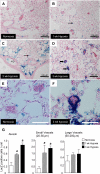Bmp2 and Bmp4 exert opposing effects in hypoxic pulmonary hypertension
- PMID: 20042692
- PMCID: PMC2838658
- DOI: 10.1152/ajpregu.00534.2009
Bmp2 and Bmp4 exert opposing effects in hypoxic pulmonary hypertension
Abstract
The bone morphogenetic protein (BMP) type 2 receptor ligand, Bmp2, is upregulated in the peripheral pulmonary vasculature during hypoxia-induced pulmonary hypertension (PH). This contrasts with the expression of Bmp4, which is expressed in respiratory epithelia throughout the lung. Unlike heterozygous null Bmp4 mice (Bmp4(LacZ/+)), which are protected from the development of hypoxic PH, mice that are heterozygous null for Bmp2 (Bmp2(+/-)) develop more severe hypoxic PH than their wild-type littermates. This is associated with reduced endothelial nitric oxide synthase (eNOS) expression and activity in the pulmonary vasculature of hypoxic Bmp2(+/-) but not Bmp4(LacZ/+) mutant mice. Furthermore, exogenous BMP2 upregulates eNOS expression and activity in intrapulmonary artery and pulmonary endothelial cell preparations, indicating that eNOS is a target of Bmp2 signaling in the pulmonary vasculature. Together, these data demonstrate that Bmp2 and Bmp4 exert opposing roles in hypoxic PH and suggest that the protective effects of Bmp2 are mediated by increasing eNOS expression and activity in the hypoxic pulmonary vasculature.
Figures






Similar articles
-
Mechanisms of Bone Morphogenetic Protein 2 in Respiratory Diseases.Curr Allergy Asthma Rep. 2024 Oct 28;25(1):1. doi: 10.1007/s11882-024-01181-7. Curr Allergy Asthma Rep. 2024. PMID: 39466470 Review.
-
Bone morphogenetic protein 4 promotes pulmonary vascular remodeling in hypoxic pulmonary hypertension.Circ Res. 2005 Sep 2;97(5):496-504. doi: 10.1161/01.RES.0000181152.65534.07. Epub 2005 Aug 11. Circ Res. 2005. PMID: 16100039
-
Bone morphogenetic protein receptor II is a novel mediator of endothelial nitric-oxide synthase activation.J Biol Chem. 2011 Sep 23;286(38):33134-40. doi: 10.1074/jbc.M111.274100. Epub 2011 Aug 1. J Biol Chem. 2011. PMID: 21808054 Free PMC article.
-
Axin2 controls bone remodeling through the beta-catenin-BMP signaling pathway in adult mice.J Cell Sci. 2009 Oct 1;122(Pt 19):3566-78. doi: 10.1242/jcs.051904. Epub 2009 Sep 8. J Cell Sci. 2009. PMID: 19737815 Free PMC article.
-
Bmp2 and Bmp4 genetically interact to support multiple aspects of mouse development including functional heart development.Genesis. 2009 Jun;47(6):374-84. doi: 10.1002/dvg.20511. Genesis. 2009. PMID: 19391114 Free PMC article.
Cited by
-
Mechanisms of Bone Morphogenetic Protein 2 in Respiratory Diseases.Curr Allergy Asthma Rep. 2024 Oct 28;25(1):1. doi: 10.1007/s11882-024-01181-7. Curr Allergy Asthma Rep. 2024. PMID: 39466470 Review.
-
Cardiac responses to 24 hrs hyperoxia in Bmp2 and Bmp4 heterozygous mice.Inhal Toxicol. 2013 Aug;25(9):509-16. doi: 10.3109/08958378.2013.808287. Epub 2013 Jul 22. Inhal Toxicol. 2013. PMID: 23876042 Free PMC article.
-
Role of Store-Operated Ca2+ Entry in the Pulmonary Vascular Remodeling Occurring in Pulmonary Arterial Hypertension.Biomolecules. 2021 Nov 27;11(12):1781. doi: 10.3390/biom11121781. Biomolecules. 2021. PMID: 34944425 Free PMC article. Review.
-
Increased Methyl-CpG-Binding Domain Protein 2 Promotes Cigarette Smoke-Induced Pulmonary Hypertension.Front Oncol. 2022 Jun 16;12:879793. doi: 10.3389/fonc.2022.879793. eCollection 2022. Front Oncol. 2022. PMID: 35785161 Free PMC article.
-
A wrinkle in time: circadian biology in pulmonary vascular health and disease.Am J Physiol Lung Cell Mol Physiol. 2022 Jan 1;322(1):L84-L101. doi: 10.1152/ajplung.00037.2021. Epub 2021 Dec 1. Am J Physiol Lung Cell Mol Physiol. 2022. PMID: 34850650 Free PMC article.
References
-
- Beppu H, Ichinose F, Kawai N, Jones RC, Yu PB, Zapol WM, Miyazono K, Li E, Bloch KD. BMPR-II heterozygous mice have mild pulmonary hypertension and an impaired pulmonary vascular remodeling response to prolonged hypoxia. Am J Physiol Lung Cell Mol Physiol 287: L1241–L1247, 2004 - PubMed
-
- Boyle S, Misfeldt A, Chandler KJ, Deal KK, Southard-Smith EM, Mortlock DP, Baldwin HS, de Caestecker M. Fate mapping using Cited1-CreERT2 mice demonstrates that the cap mesenchyme contains self-renewing progenitor cells and gives rise exclusively to nephronic epithelia. Dev Biol 313: 234–245, 2008 - PMC - PubMed
-
- Butt E, Abel K, Krieger M, Palm D, Hoppe V, Hoppe J, Walter U. cAMP- and cGMP-dependent protein kinase phosphorylation sites of the focal adhesion vasodilator-stimulated phosphoprotein (VASP) in vitro and in intact human platelets. J Biol Chem 269: 14509–14517, 1994 - PubMed
-
- Coggins MP, Bloch KD. Nitric oxide in the pulmonary vasculature. Arterioscler Thromb Vasc Biol 27: 1877–1885, 2007 - PubMed
Publication types
MeSH terms
Substances
Grants and funding
LinkOut - more resources
Full Text Sources
Medical
Molecular Biology Databases

